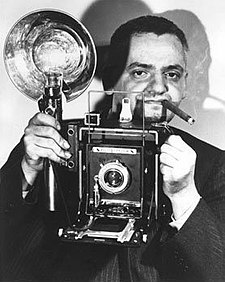Weegee
| Weegee | |
|---|---|
 |
|
| Born |
Ascher (Usher) Fellig June 12, 1899 Złoczów, Galicia, Austria-Hungary (now Zolochiv, Ukraine) |
| Died | December 26, 1968 (aged 69) New York City, New York, U.S. |
| Other names | Arthur Fellig |
| Occupation | Photographer |
| Known for | Street photography of crime scenes or emergencies |
Weegee was the pseudonym of Arthur (Usher) Fellig (June 12, 1899 – December 26, 1968), a photographer and photojournalist, known for his stark black and white street photography. Weegee worked in Manhattan, New York City's Lower East Side as a press photographer during the 1930s and 1940s, and he developed his signature style by following the city's emergency services and documenting their activity. Much of his work depicted unflinchingly realistic scenes of urban life, crime, injury and death. Weegee published photographic books and also worked in cinema, initially making his own short films and later collaborating with film directors such as Jack Donohue and Stanley Kubrick.
Weegee was born Usher Fellig in Złoczów (now Zolochiv, Ukraine), near Lemberg in Austrian Galicia. His given name was changed to Arthur when he emigrated with his family to New York in 1909. There he took numerous odd jobs, including working as an street photographer of children on his pony and as an assistant to a commercial photographer. In 1924 he was hired as a darkroom technician by Acme Newspictures (later United Press International Photos). He left, however, in 1935 to become a freelance photographer. Describing his beginnings, Weegee stated:
In my particular case I didn't wait 'til somebody gave me a job or something, I went and created a job for myself—freelance photographer. And what I did, anybody else can do. What I did simply was this: I went down to Manhattan Police Headquarters and for two years I worked without a police card or any kind of credentials. When a story came over a police teletype, I would go to it. The idea was I sold the pictures to the newspapers. And naturally, I picked a story that meant something.
He worked at night and competed with the police to be first at the scene of a crime, selling his photographs to tabloids and photographic agencies. His photographs, centered around Manhattan police headquarters, were soon published by the Herald Tribune, World-Telegram, Daily News, New York Post, New York Journal American, Sun, and others.
...
Wikipedia
